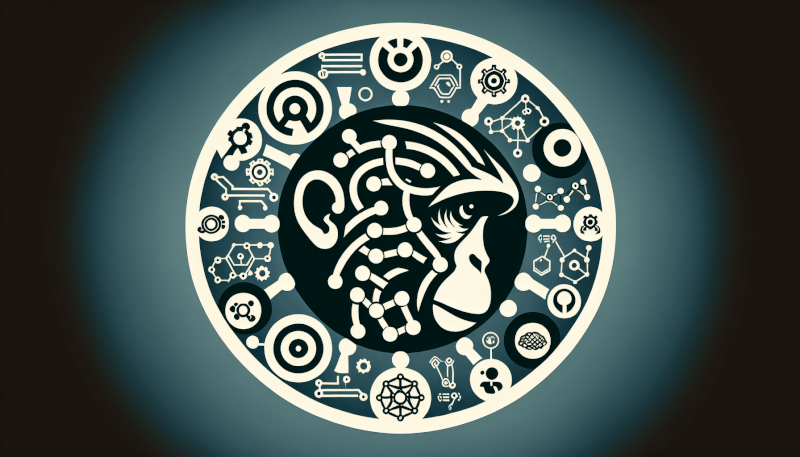Have you ever wondered how primates interact and form complex social structures? If so, then you will be intrigued by the fascinating world of primate social dynamics. Through observational research, scientists have gained valuable insights into the intricate relationships, hierarchical systems, and communication methods of these intelligent beings. By closely observing primate communities in their natural habitats, researchers have uncovered a wealth of knowledge that not only deepens our understanding of primate behavior but also provides valuable parallels to our own social interactions. Embark on a journey to unravel the secrets of primate social dynamics and discover the striking similarities between our world and theirs.
Social Organization of Primates
Hierarchical Structure
Primate societies are often organized in a hierarchical structure, with individuals ranked according to their dominance or social status. This dominance hierarchy determines access to resources such as food, mates, and territory. Higher-ranking individuals have priority access to these resources, while lower-ranking individuals must defer to them. The hierarchical structure is maintained through various social behaviors and interactions, which help to establish and reinforce the dominance relationships within the group.
Types of Social Groups
Primates can form different types of social groups, depending on factors such as species, habitat, and social dynamics. Some primates live in small, cohesive groups known as “one-male, multi-female” groups, where one dominant male mates with multiple females. Others form larger, multi-male, multi-female groups, where multiple males and females live together. Some primates, such as orangutans, are primarily solitary, with minimal social interactions.
Dominance and Subordination
Dominance and subordination play a crucial role in primate social organization. Dominant individuals exhibit behaviors such as aggression, intimidation, and assertion of control to maintain their higher social status. Subordinate individuals, on the other hand, must display submission and deference to the dominant individuals. These hierarchical relationships help to reduce conflict within the group and facilitate resource allocation.
Methods of Observational Research
Naturalistic Observation
Naturalistic observation involves observing primates in their natural habitat without interfering with their behavior. Researchers rely on careful observation and documentation of primate social interactions, communication, and daily activities. This method provides valuable insights into primate social dynamics without disrupting their natural behavior patterns.
Focal Animal Sampling
Focal animal sampling focuses on observing a specific individual or focal animal for a predetermined duration. Researchers record behaviors, social interactions, and any other relevant data involving the focal animal. This method allows researchers to gain a detailed understanding of individual behavior and social relationships within a group.
Scan Sampling
Scan sampling involves observing a group of primates at regular intervals, recording the behaviors being displayed by each individual at that given moment. This method provides an overall snapshot of group dynamics and allows researchers to study the distribution of behaviors within the group.
Behavioral Sampling
Behavioral sampling involves systematically recording specific behaviors of interest, such as aggression, grooming, or feeding. Researchers collect data by carefully documenting the frequency, duration, and context of these behaviors. This method helps to quantify and analyze primate behavior patterns and social interactions.

Types of Primate Social Interactions
Agonistic Interactions
Agonistic interactions refer to social interactions involving conflict or aggression. These behaviors serve to establish dominance, defend resources, or resolve disputes within the group. Aggression can range from subtle displays, such as threat postures and vocalizations, to more overt acts of physical aggression. Agonistic interactions are an essential component of primate social dynamics and help to establish and maintain the hierarchical structure.
Affiliative Interactions
Affiliative interactions involve behaviors that build and maintain social bonds within a primate group. These behaviors can include grooming, play, and social grooming. Affiliative interactions help to strengthen social relationships, reduce tension, and promote cooperative behaviors within the group.
Sexual Interactions
Sexual interactions play a critical role in primate social dynamics, as they are essential for reproductive success. These interactions include courtship displays, mating, and reproductive behaviors. The nature and complexity of sexual interactions vary among different primate species, with some species exhibiting elaborate courtship rituals and others having more promiscuous mating systems.
Parental Interactions
Parental interactions involve the care and nurturing of offspring. Primates exhibit a wide range of parental behaviors, including carrying, grooming, and nursing their young. These interactions are crucial for offspring survival and contribute to the formation of social bonds within primate groups.
Factors Influencing Primate Social Dynamics
Food Availability
Food availability plays a significant role in shaping primate social dynamics. The distribution and abundance of food resources can influence the size and composition of social groups, as well as the degree of competition and cooperation among individuals. In times of scarcity, competition for limited resources may intensify, leading to increased aggression and social tension.
Habitat
The habitat in which primates live also influences their social dynamics. Different habitats provide varying levels of resources and offer different challenges and opportunities for primate groups. For example, forest-dwelling primates may have different social structures and behavior patterns compared to those living in open grasslands. Habitat characteristics can influence factors such as group size, territoriality, and resource availability.
Species Interactions
Interactions between different primate species can have profound effects on social dynamics. Coexistence with other primate species may lead to competition for resources and spatial overlap. In some cases, different primate species may form mixed-species associations, benefiting from feeding together or engaging in mutual defense against predators. These species interactions can shape social behaviors and influence the overall structure of primate communities.
Predation Risk
The risk of predation can impact primate social dynamics. The presence of predators can shape behavior patterns, leading to increased vigilance, group cohesion, and cooperative antipredator strategies. Primate groups may modify their social interactions and space usage to mitigate predation risk, resulting in changes in group dynamics and social structure.

Communication in Primate Societies
Vocal Communication
Primates use various vocalizations to communicate within their social groups. From simple vocal calls to complex vocalizations, such as songs and alarm calls, vocal communication plays a crucial role in conveying information about social status, territory, group cohesion, and alarm signals. Different vocalizations serve different functions, allowing individuals to coordinate their behavior and maintain social bonds within the group.
Visual Communication
Visual communication is another important aspect of primate social dynamics. Primate species utilize a range of visual signals, including facial expressions, body postures, and gestures, to convey information such as submission, aggression, appeasement, and reproductive readiness. These visual cues are vital for maintaining social order, resolving conflicts, and facilitating social interactions.
Chemical Communication
Chemical communication, through the use of pheromones and other chemical signals, also plays a role in primate social dynamics. Primates use scent marking to delineate territory, attract mates, and signal reproductive status. Chemical signals can convey information about dominance, individual identity, and even emotional states. By detecting and interpreting these chemical cues, primates can establish and maintain social relationships within their group.
Primate Social Learning
Observational Learning
Observational learning is a vital component of primate social dynamics. Through observation, primates can learn from the behaviors and actions of others within their social group. This type of learning allows individuals to acquire new skills, acquire knowledge about food sources, and learn social norms and customs. Observational learning contributes to the transmission of cultural behaviors throughout generations and facilitates the acquisition of complex social behaviors.
Imitation
Imitation is another form of social learning in primates. Individuals observe and mimic the actions and behaviors of others within their group. This form of learning enables the acquisition of motor skills and the replication of complex behaviors. Imitation also plays a role in the transmission of cultural knowledge and traditions within primate communities.
Teachings
In certain primate species, individuals actively engage in teaching behaviors, where experienced individuals guide and instruct younger members of the group. These teaching interactions provide opportunities for learning and skill acquisition, enhancing the social and cognitive development of the younger individuals. Teachings can include demonstrations of foraging techniques, tool use, and social interactions.
Cultural Transmission
Cultural transmission refers to the transfer of information, behaviors, and traditions from one generation to the next within a primate community. Through social learning and teaching interactions, primates pass on a range of cultural behaviors, such as tool use, grooming rituals, and vocalizations. Cultural transmission contributes to the diversity and adaptability of primate societies, as it allows for the accumulation and refinement of knowledge and skills over time.

Conflict Resolution and Cooperation
Altruism and Cooperation
Altruism and cooperation are important aspects of primate social dynamics. Altruistic behaviors involve individuals acting in the best interest of others, even at their own expense. This can include behaviors like food sharing, protecting group members from predators, and cooperative breeding strategies. Cooperation within a group promotes social cohesion, increases group success, and enhances individual reproductive fitness.
Reconciliation
After a conflict or aggressive interaction, reconciliation behaviors can occur in primate groups. Reconciliation is the process of repairing social relationships and reducing tension between individuals. Behaviors such as grooming, embracing, and vocalizations contribute to the restoration of social bonds and the maintenance of group harmony. Reconciliation plays a vital role in reducing the negative impacts of conflicts and promoting cooperation within the group.
Social Bonds and Alliances
Primates form social bonds and alliances with other group members. These bonds are typically based on close affiliative relationships, such as grooming partnerships and cooperative behaviors. Social bonds promote group stability, provide social support, and contribute to individual well-being. Alliances formed between individuals or subgroups can also enhance social standing, provide protection against aggression, and facilitate resource access.
Primate Mating Systems
Monogamy
Monogamy is characterized by the formation of pair bonds between one male and one female. Monogamous primate species often exhibit high levels of cooperation and shared parental care. Pair-bonded individuals may mate exclusively with each other to ensure paternal certainty and invest in the survival and well-being of their offspring. Monogamy allows for the development of long-term social bonds and promotes stability within primate groups.
Polygamy
Polygamy refers to mating systems in which individuals have multiple mates. There are two types of polygamy: polygyny and polyandry. Polygynous species involve one male mating with multiple females, while polyandrous species involve one female mating with multiple males. Polygamy can result in increased competition among individuals and can lead to the establishment of dominance hierarchies within the group. This mating system allows for increased genetic diversity and potential reproductive success for both males and females.
Promiscuity
Promiscuity is characterized by multiple, non-exclusive sexual relationships within a group. Promiscuous mating systems can be found in some primate species where there is a lack of strong pair bonds or clear dominance hierarchies. Promiscuity allows for increased sperm competition and genetic diversity within a group, but may also lead to increased aggression and conflict over mating opportunities.
Polyandry
Polyandry is a rare mating system where one female mates with multiple males. This unusual arrangement can be seen in certain primate species where environmental conditions or social dynamics favor polyandrous mating. Polyandry can provide benefits such as increased paternal investment, reduced infanticide risk, and shared parental care. This mating system challenges traditional assumptions about primate social dynamics and highlights the complexity of primate mating strategies.

Primate Parental Care
Maternal Care
Primate mothers play a vital role in the care and upbringing of their offspring. Maternal care can include nursing, carrying, grooming, and protecting the young. Maternal investment ensures the survival and well-being of the offspring and contributes to the development of strong social bonds within primate groups. Maternal care also allows for the transfer of cultural knowledge and social behaviors from mother to offspring.
Paternal Care
Although less common than maternal care, paternal care is observed in some primate species. Males may participate in parental care by carrying, grooming, and protecting their offspring. Paternal care can provide additional support and resources for the offspring, enhance social bonds within the group, and contribute to the overall success of the group.
Siblings and Cooperative Care
In addition to maternal and paternal care, primate siblings may also play a role in the care and upbringing of younger siblings. Older siblings can assist in carrying, grooming, and protecting the younger siblings, contributing to their survival and socialization. Cooperative care within primate groups helps distribute the demands of parental care and promotes social bonding and cooperation among group members.
Challenges of Studying Primate Social Dynamics
Observer Bias
Observational research can be influenced by observer bias, where the researchers’ expectations or preconceived notions influence their interpretations of primate behaviors. It is important for researchers to be aware of their biases and employ rigorous methodologies to minimize their impact on data collection and analysis. Multiple observers and inter-observer reliability checks can help reduce observer bias and increase the reliability of research findings.
Sampling Limitations
Researchers studying primate social dynamics often face sampling limitations. The size and behavior of primate groups can make it challenging to observe and record the behaviors of all individuals within the group. Researchers must carefully select appropriate sampling methods and sample sizes to ensure that the observed behaviors are representative of the entire group. These limitations can impact the generalizability and accuracy of research findings.
Long-term Studies
Primate social dynamics are complex and can change over time. Conducting long-term studies that span multiple generations allows researchers to gain a comprehensive understanding of the dynamics within a primate group. However, long-term studies are resource-intensive and require sustained funding and commitment. Longitudinal research is essential in capturing the intricacies of primate social behavior and the underlying factors that drive social change.
Ethical Considerations
Studying primate social dynamics must be conducted with careful ethical considerations. Researchers must ensure that their studies do not disrupt or harm the natural behaviors and well-being of primate groups. Research protocols should adhere to ethical guidelines and minimize the impact on the animals’ welfare. It is important to strike a balance between the scientific objectives and the ethical treatment of the study subjects, ensuring that the research benefits outweigh any potential harm to the primates involved.
In conclusion, understanding primate social dynamics requires careful observational research. By studying the hierarchical structure, social interactions, communication, learning, mating systems, parental care, and various factors influencing these dynamics, researchers can gain valuable insights into the complex social lives of primates. Through rigorous and ethical research methods, scientists continue to unravel the intricacies of primate social organization, contributing to our broader understanding of primate behavior and human evolution.



